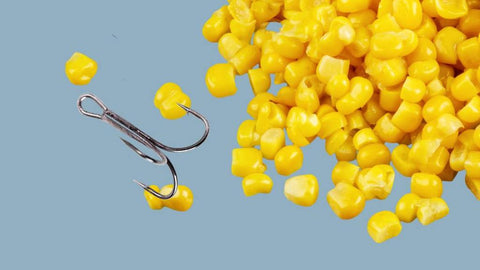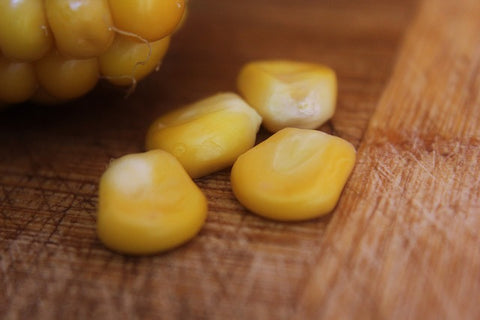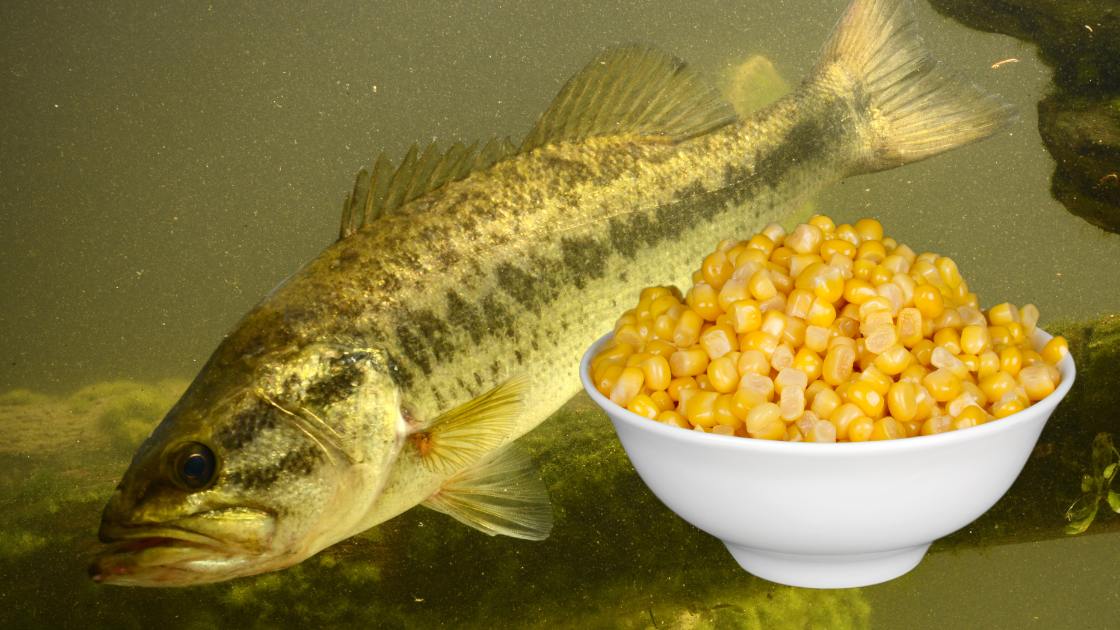Table of Contents
The use of corn as fishing bait has been a favorite among anglers, whether pro or beginner, for quite some time. The common golden grain is a go-to for catching a variety of fish, won't burn a hole in your pocket, and can be used in a bunch of creative ways.
But it’s also caused a lot of confusion and controversy among fishing enthusiasts, because of two reasons: one, some states have specific regulations in place about the use of corn as bait or in chumming, and two, because of concerns surrounding its impact to the environment and on fish.
As responsible anglers, it's important for us to get down to the kernel (pun intended!) of the issue of using corn as fishing bait to make informed decisions, and uphold sustainability. In the end, if you want to avoid using corn as bait altogether, there are also lots of substitutes that also combine what makes corn such a great fishing bait: affordability, ease of use, and accessibility.

Why is corn a popular fishing bait?
Corn is a popular fishing bait for several practical reasons.
- Versatile: Corn is effective in attracting a variety of fish species. Some of the kinds of fish you can catch with corn include carp, bass, trout, panfish, and mullet. Corn also works well with different hook sizes, making it suitable for anglers of all skill levels. You can also mix it up with other baits or toss it into your prebaiting mix.
- Budget-friendly: Compared to other kinds of bait, corn is readily available and costs less than a dollar for a can at most retailers. And if you don't want to go for the canned version, fresh, frozen, or even dry feed corn also work. Dry, frozen, and canned corn also remain usable for long periods of time, making it a practical choice for anglers who plan to store bait for future fishing trips.
- Ease of use: Corn is pretty easy to handle and rig (more on this in the section How to use corn as fish bait below). It's also convenient, as it stays on hooks quite well.
- Visibility and taste: The bright color of corn makes it noticeable underwater, attracting fish to your bait. Its sweet taste can be appealing to many fish species, especially in freshwater.

How to use corn as fish bait
- Using corn as fish bait is as straightforward as it gets. The most basic way to use it is to pick up a kernel of corn and gently thread it onto your hook. The hook should pierce through the top of the kernel and exit through the bottom. This will secure the corn onto the hook while also preserving its natural shape and color. It’s crucial to make sure that the corn is attached securely. Otherwise, it may fall off while casting or when the fish strikes. You can add more than one kernel if your hook size allows it.
- If you want to change things up a bit - which I often recommended if you haven’t been as successful in catching fish with corn as you’d have hoped - there is room for experimentation. You can try placing the corn at different positions on the hook to see what gets the best results. Some anglers swear by having the corn at the tip of the hook while others place it near the bend. Just remember to leave some parts of the hook exposed for a better chance at success.
- Adding a weight to your fishing line is optional but could prove useful in certain circumstances. If you’re fishing in deeper waters or you want your bait to cover a wider area, a small weight can be attached to the line above the hook. The added weight will allow the bait to sink faster and reach depths where bigger fish might be lurking. A bobber can also be added to maintain the bait at a specific depth, especially when targeting species that are not bottom feeders.
- Before casting your line, give the corn a gentle pull to ensure it's tightly secured to the hook. The last thing you want is for it to slip off mid-cast or just as a fish bites.
What are the environmental concerns related to using corn in fishing?
As keen anglers who value our environment, we must consider the potential ecological impacts of using our chosen bait. While corn is undeniably a handy and efficient option, its usage does come with certain environmental concerns. These considerations highlight the importance of practicing responsible and sustainable fishing.

For one, overfeeding can be a real problem. If fish indulge in too much corn bait, it could lead to weight gain and general health decline. This has the potential to upset the balance of our local ecosystems and can negatively affect native fish populations.
Secondly, we need to consider the possible harm to the fish. Certain species of fish may struggle to properly digest corn, which can block their intestines or stomach. This could potentially lead to their death from internal buildup. It's a must to take some time research and understand the dietary habits and digestive capacities of the fish species we're aiming to catch.
Let’s not forget about the mess. Corn bait can often leave uneaten kernels and residue in the water. This not only looks unattractive but can also lure other unwanted animals. And if we're not careful with how we discard corn bait, we could contribute to the pollution and health of our favorite fishing spots.
Is fishing with corn legal or illegal?
Most states allow the use of corn as fishing bait. But, there are exceptions. For example, in Rhode Island, using corn for bait is against the law.
Another thing to consider is 'chumming' – this is when you scatter something like corn in the water to attract fish. The states where chumming with corn is illegal include California (except for Salton Sea), Colorado, Hawaii, Idaho, Kentucky, Maine, Michigan, Minnesota, Nevada (but not Lake Mead), North Dakota, Oregon, Rhode Island, South Carolina, Utah (except for Lake Powell), and Vermont.
It is always best to check and be updated on local fishing regulations to ensure that using corn as bait or chumming with corn is legal in your area. Keep in mind that violating fishing regulations could lead to harsh penalties such as fines, license suspensions, and in certain circumstances, even criminal charges.

What can you use as alternatives to corn in fishing?
If you're considering avoiding the use of corn as bait, there are quite a few alternatives that are equally, if not more, effective (depending on the circumstances).
The traditional option, worms, always proves successful for various fish species. You can conveniently pick them up from a bait and tackle shop or even dig them up from your backyard.
Another option is insects like crickets, grasshoppers, and mealworms, which are especially appealing to trout and panfish. Another go-to bait known to attract bass, walleye, and pike are minnows, which can be bought from a tackle shop or caught using your own minnow trap.
Crayfish, part of the natural diet for many fish, are effective in luring in species like bass and catfish. If you prefer, there's also cut bait, which consists of chunks of fish used as bait.
Lastly, don't discount artificial baits such as lures and jigs. With their variety of shapes, sizes, and colors, they can mimic the look and movement of natural prey, and can be reused multiple times.
Don't miss our posts on Top Baitfish for Freshwater and Saltwater Fishing and 5 Popular Artificial Fishing Lures!

Conclusion
Corn is has always been a top pick for fishing because of how cheap, versatile, and effective it is as bait. But before you pop that kernel on a hook and casting out into the water, it's a good idea to think about the bigger picture. Some local rules are pretty strict about using corn due to concerns about the environment and the health of our fishy friends. And since we all want our waters and fish to stay healthy for years to come, taking a deep dive into this issue is crucial. Finally, if you decide to avoid corn as bait, there are heaps of other alternatives to try. Fish on!
Need a fishing tackle backpack for your next adventure? Check our our recommendation!
MOST READ NEWS:
How To Use Your Fishing Records to Catch More Fish
Track your fishing trips, analyze patterns, and refine your techniques with a fishing log to catch more fish on every outing!
Solo Fishing Safety Tips: Stay Safe and Enjoy the Outdoors
Learn essential solo fishing safety tips: gear checklist, boat safety, emergency preparedness, weather monitoring & fishing location scouting. Stay safe on the water.
Secrets to Winter Fly Fishing Success
Master winter fly fishing with expert tips on trout behavior, essential gear, and proven techniques. Learn the secrets to catching more fish in cold weather.
How Cold Water Changes Fish Behavior: Insights for Anglers
Explore how cold water affects fish behavior and fishing techniques, enhancing your angling success and strategy.
Is Tech Making Fishing Too Easy? Exploring Forward-Facing Sonar (FFS)
Learn about forward facing sonar in fishing - what it is, how it works, rules for tournaments, ethics, and tips for finding fish with this game-changing technology.
Plan Your Best Fishing Trip Yet this 2025: A Complete Guide
Plan your fishing trip this off-season. Learn to choose destinations, prep gear, pick bait, and trust Baitium for expert tools and tips!
15 Fishing Resolutions for 2025: Set Yourself Up for Success
Discover 15 essential fishing resolutions for 2025: tackle organization, gear maintenance, angling techniques, conservation tips, tournament prep, and fishing safety guidelines.


